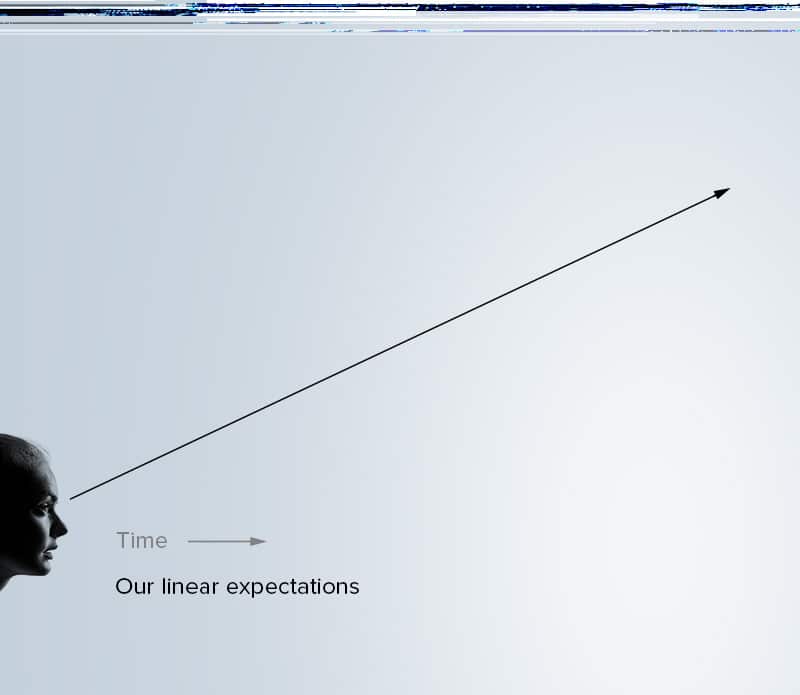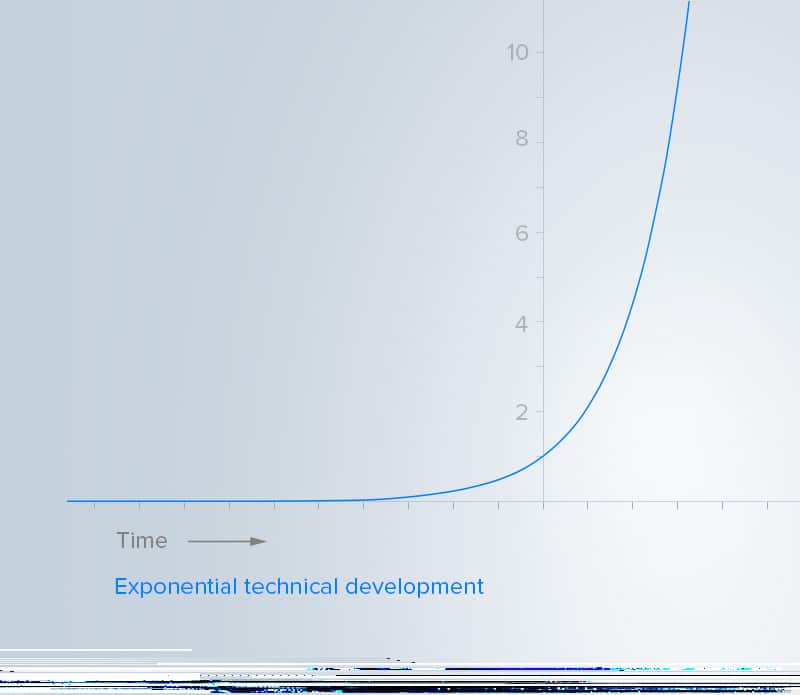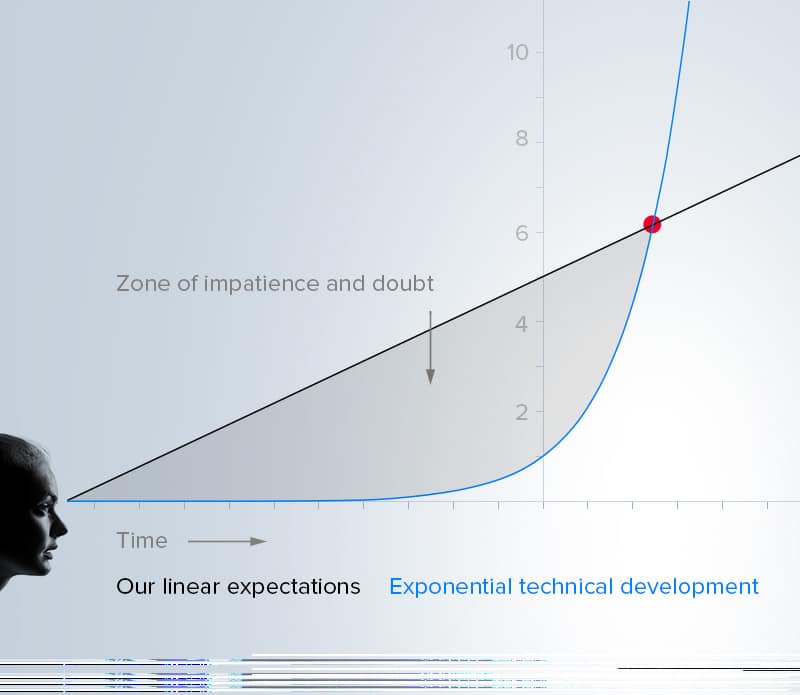Dare to disrupt: Preparing for change in a time of exponential growth
Disruption will affect us all. So, how do you make sure you’re the disruptor and not the disrupted?
To gain control of disruption, we need to understand why disruption happens in the first place. To do that, we need to talk about human behavior and, well, math. I’ll try to keep it brief and interesting, and as we get into it, I think you’ll agree this is fascinating stuff.
Linear intuition vs technology’s exponential growth
Making predictions about pending events is a critical part of running a business. As humans, we depend on our intuitive ability to make predictions about likelihood and possibility. This intuitive pattern-recognition skill evolved long ago as a tactic for survival. And it has served humanity pretty well—so long as the landscape is generally consistent, and change appears relatively constant, for the most part it works.
But change in technology is not intuitively linear—it’s exponential.
Virtually every technology sector we can point to today is advancing exponentially—driven in large part by the exponential advancement of computer processing power, which itself is powering the development of all other technologies in various ways.
As a result, there is a critical disconnect between what we all intuitively assume about the rate of change in technology and the actual pending events we are likely to see. Unfortunately, we tend to incorrectly predict advancement as being both faster than it is now, and slower than it will be soon.
It happens like this:
We hear about some new technical domain, we are excited by the promise of it, and we visualize it improving in a common-sense intuitive-linear progression. If graphed, this would appear to be a generally straight, upward angled line.


But as we await the appearance of progress, we are rapidly let down. It does not seem that the promise of the technology is manifesting at all. Indeed, as more time passes we come to discount the technology as a prospect in the foreseeable future.
This is because technology, growing exponentially and dutifully doubling at each increment, in the beginning stays so very close to zero for such a long time that we don’t really notice the change.
So on a graph where we are measuring technological advancement between 0 and 10—where 0 is the mere promise of the technology and 10 is a fully functioning ideal state—it takes an excruciatingly long time to get to the whole number 1.
The line on the graph moves forward in equal increments, but stubbornly sits on what appears to our eye to be zero for a very long time:


Many, many increments later, we finally arrive at the whole number 1, the smallest whole number on the graph. And from there, with the magic of exponential growth, we are quite suddenly only 4 more equally spaced increments from skyrocketing off the chart!
Where all of this gets interesting is when we then lay our linear expectations over the technology’s true exponential growth:


Don’t be fooled by the deceptive zone of doubt
As you can see, for quite a while our expectations go unmet. Where are the robots? Where are the self-driving cars? Where is the Holodeck? The promise of these technologies begins to seem unfounded, or at least a very long way off.
Progress sits well below our linear expectations, so we grow tired of waiting for it. We find ourselves lulled into complacency. “Maybe it won’t disrupt my business or my job after all—or at least not while I’m alive,” we may think.
This is the deceptive zone of doubt. And it’s during this time that we can lose interest in planning and innovating. Indeed, we may feel reassured that our business model is in less danger than we first thought.
But we’ve only been lulled into that belief.
Do you see that intersection point on the right side (the red dot) where the technical growth line shoots past our linear expectations? This is where companies, executives, and those of us in the workforce get caught completely by surprise.
This, my friends, is the door to disruption. And I’m not talking about a little bump in the road—I mean past that intersection point is where Tower Records and Blockbuster Video died. It’s where Blackberry stumbled. And it’s something advertisers, publishers, and television broadcasters are facing today.
It’s the competition that the hotel industry is facing from Airbnb, and that longstanding taxi and limo companies are facing from companies like Uber and Lyft. In fact, as exponentially fueled innovations come ever more rapidly, even Uber, a disruptive company itself, is already realizing that its own business model is under certain threat of obsolescence as that inevitable fleet of self-driving cars is gearing up for production.
And conditions like this will just keep happening, even faster, in virtually every business sector. So, what can you do about it? Being aware of the exponential disconnect is just half the battle.
Build your own Black Ops team
Salim Ismail, author of Exponential Organizations, suggests that businesses need to develop corporate Black Ops teams whose goal is specifically to disrupt their own business. To break it. On purpose. To find and innovate the solution that will put the company out of business, and then of course to make that their business.
Look for crossover in unexpected places. Look for intersections between technologies. What happens when you apply AI to your business? How could you change the way you or your company operates? What happens when nanotech meets medicine? When robotics meets conservation and sustainability? The possibilities are endless.
Amazon is surely trying hard, and with some success, to do this. Developing drone delivery programs, the Kindle, Fire TV, and Amazon Echo, Amazon is taking control of technical innovations that shorten home-delivery to the point of satisfying instant gratification, utilizing robotics, and developing proprietary in-home technology platforms that will allow the company to maintain its lead as a seller of products into the digital future. Amazon is plainly working to disrupt its own business.
Facebook has taken a slightly less imaginative and possibly more costly approach. Rather than spending the few hundred thousand dollars (several times over) to innovate and test competitive new models, Facebook lies in wait until someone else develops a solution that threatens its position. And then Facebook simply acquires it, paying rather chokingly significant sums in the process. Instagram and WhatsApp, it seems, may have been wise purchases. It remains to be seen whether Oculus Rift was wise as well. Although there can be no question that virtual reality is in our future, it is not yet clear whether hardware, or software, is going to be the VR platform to profitably dominate.
Research the technical landscape and develop your creative-thinking skills
As a business student mastering your business skills or perhaps entering the workforce for the first time, you are in an ideal situation to take in the technical changes happening around you. Indeed, I’d argue, you must. So take some time to explore the technical landscape and the surprising number of disruptive opportunities that are growing around us.
Research the top technology conferences in your preferred industry and attend at least one annually. And in the meantime, stay current through research, your courses at Hult, and self-study. Favor classes, books, and activities designed to expand and strengthen your creative thinking.
Remember, in the same way that exponential technologies can disrupt businesses, they will inevitably disrupt individual specialties and careers too. The full scope of problems in our future can’t be known, so there is no specific technology you can learn that will guarantee your skills or career will stay relevant.
The best way to be certain that you will rise above this ongoing threat of obsolescence is to develop strong creative, problem-solving skills so you are able to identify and wield future, unpredictable innovations and trends as they appear.
Stay curious, creative, and nimble, and constantly evaluate the changing state of the technology. If you do, you can be the disruptor.
“The best way to be certain that you will rise above this ongoing threat of obsolescence is to develop strong creative, problem-solving skills so you are able to identify and wield future, unpredictable innovations and trends as they appear. Stay curious, creative, and nimble.”
Interested in finding out more about Hult’s future-focused programs and how disruptive tech is built into your course? Download a brochure.
Like game changers? Break the mould in the business world with a Masters in Disruptive Innovation from Hult. To learn more, take a look at our blog Hult alumni in disruptive technology: Is this Blockchain’s year? or explore overall business challenges with a Masters in International Business instead. Download a brochure or get in touch today to find out how Hult can help you to find out everything about the business world, the future, and yourself.


